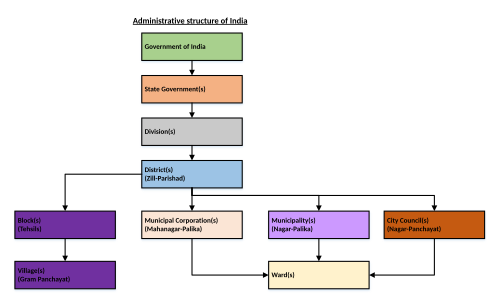| This article uses bare URLs, which are uninformative and vulnerable to link rot. Please consider converting them to full citations to ensure the article remains verifiable and maintains a consistent citation style. Several templates and tools are available to assist in formatting, such as reFill (documentation) and Citation bot (documentation). (August 2022) (Learn how and when to remove this message) |
Block Pramukh (transl. President of Block Panchayat) is a term used in India to refer to the elected head of a Panchayat Samiti or Block Panchayat. The Panchayat samiti is a tier of the Panchayati raj system. It is a rural local government body at the Tehsil (block) level in India. It works for the villages of the tehsil that together are called a development block. The Panchayat Samiti is the link between the gram panchayat (village council) and the zila parishad (district panchayat or district board). There are a number of variations in the name of this institution in the various states. For example, it is known as Kshetra Panchayat in Uttar Pradesh, Mandal Parishad in Andhra Pradesh, Taluka Panchayat in Gujarat, Block Panchayat in Kerala, and Mandal Panchayat in Karnataka.
Block Pramukhs are Panchayats at the Apex or District Level in Panchayat Raj Institutions (or PRIs).
The 73rd Amendment is about Rural Local Governments (which are also known as Panchayati Raj Institutions or PRIs)
- Panchayat at District(or apex) Level
- Panchayat at Intermediate Level
- Panchayat at Base Level
Composition

Typically, a panchayat samiti is composed of elected members of the area, and the Block Development Officer, otherwise unrepresented members (representatives of Scheduled Castes and Scheduled Tribes and women), associate members (such as a farmer of the area, a representative of the cooperative societies, and one from the agricultural marketing services sector), and the elected members of that panchayat block (tehsil) on the zila parishad (district board).
The samiti is elected for five years and is headed by a Block Pramukh(President) elected by the members of the panchayat samiti.
Departments
The most common departments found in a panchayat samiti are:
- Administration
- Finance
- Public works (especially water and roads)
- Agriculture
- Health
- Education
- Social welfare
- Information Technology
- Women & Child Development
- Panchayat raj ( Mandal Praja Parishad )
Each department in a panchayat samiti has its own officer, most often these are state government employees acting as extension officers, but occasionally in more revenue-rich panchayat samiti, these may be local employees. A government appointed block development officer (BDO) is the supervisor of the extension officers, and executive officer to the panchayat samiti and becomes, in effect, its administrative chief over all operations.
Functions
Panchayat Samiti collects all the prospective plans prepared at Gram Panchayat level and processes them for funding and implementation by evaluating them from the angles of financial constraints, social welfare and area development. It also identifies and prioritizes the issues which need to be addressed at block level.
Sources of income
The income of the panchayat samiti comes from four sources:
- taxes levied upon land and water usage, professional taxes, liquor taxes, and others
- income generating programmes
- grants-in-aid and loans from the State Government and the local zila parishad
- voluntary contributions
For many of the panchayat samiti, the main source of income becomes state aid. For others, the traditional taxing function provides the bulk of revenues. Tax revenues are often shared between the gram panchayats and the panchayat samiti.
References
- ^ Sarkar, Siuli (2010). "7.3.3 Panchayat Samiti". Public Administration In India. New Delhi: PHI Learning Private Ltd. pp. 178–180. ISBN 978-81-203-3979-8.
- "Block pramukh elections: SP claims '80% victory', others wait for 'details'". 8 February 2016.
- "यूपी के 313 ब्लाकों में सपा का परचम लहराया".
- "State Election Commission::UP".
- http://www.ncert.nic.in/ncerts/textbook/textbook.htm?keps2=8-10
- ^ Singh, Vipul (2010). "Section II Civics: Chapter 8 Rural Local Self-Government". Longman History & Civics ICSE 9. Noida, Uttar Pradesh, India: Dorling Kindersley (India) Private Ltd. p. 265. ISBN 978-81-317-2041-7.
- Arora, Ramesh Kumar & Goyal, Rajni (1995). "Chapter 17 Panchayat Raj: Struggle For Effectiveness". Indian Public Administration: Institutions and Issues (second ed.). New Delhi: Wishwa Prakashan. pp. 298–300. ISBN 978-81-7328-068-9.
- ^ Singh 2010, p. 264
- "Section A Civics: Chapter 7 Local Self-Government". History & Civics IX (eighth ed.). New Delhi: Rachna Sagar Private Ltd. 2011. p. 67. ISBN 978-81-8137-083-9.
- ^ Madan, G. R. (1990). "Chapter 16 Panchayati Raj". India's Developing Villages (second ed.). New Delhi: Allied Publishers. p. 343. ISBN 978-81-7023-281-0.
External links
- Block Pramukh Election UP 2021 Archived 2021-07-20 at the Wayback Machine
| State of Uttarakhand | |||||||||||||||||||
|---|---|---|---|---|---|---|---|---|---|---|---|---|---|---|---|---|---|---|---|
| State capitals: legislative: Dehradun (winter); Bhararisain (summer); judicial: Nainital | |||||||||||||||||||
| Government |
| ||||||||||||||||||
| History |
| ||||||||||||||||||
| Geography and ecology |
| ||||||||||||||||||
| Demographics |
| ||||||||||||||||||
| Administrative divisions |
| ||||||||||||||||||
| Politics | |||||||||||||||||||
| Tourism |
| ||||||||||||||||||
| Sports | |||||||||||||||||||
| Other topics | |||||||||||||||||||
| Districts |
| ||||||||||||||||||
| Major cities | |||||||||||||||||||